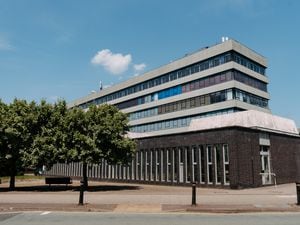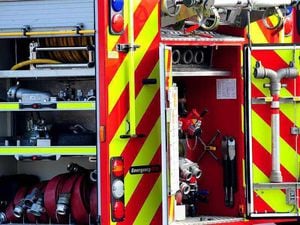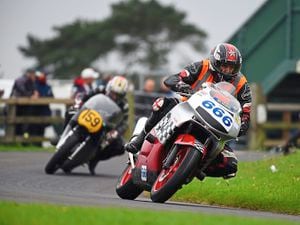The Falklands 40 years on: Blinded on board HMS Antrim
Peter Rhodes has met many Falklands veterans over the years. Here we reproduce interviews written by Peter 40 years ago.

The last thing Terry Bullingham ever saw was two Argentinian Mirage jets, head-on.
“It was like an air show,” he recalls at his Smethwick home. “They were so low and going too fast to register properly. Then there was a sound like calico ripping, only many times louder.”
It was the roar of the warplanes opening fire with their cannon. Shells exploded around the flight deck of the Royal Navy destroyer HMS Antrim.
Chief Petty Officer Bullingham felt “a sickening blow” and, at the age of 37, his world went black. It was May 21, 1982. HMS Antrim, providing air defence for the troopship Canberra, had been struck by two Argentinian bombs which failed to explode. Next came a strafing attack which left a cluster of crew injured and CPO Bullingham blinded.
“We heard this huge metallic ring as the bomb struck. We didn’t know whether it had gone off or not. We were busy cooling the decks with water. Then we saw the Mirages. I was hit in the arms and leg. I remember going into the foetal position. Someone said, ‘You’ve got a couple of black eyes’ and I thought, he’s lying.”
Terry Bullingham was relentlessly upbeat. If you have to be blinded, he said, it’s far better to lose it instantly.
“It just went black. No shades of grey. No flashes of light. No anxiety. Nothing to distract your brain. Just total blackness and two plastic eyes. Now you see it, now you don’t.”
He stayed in the Navy for two years after the Falklands War, working as a guide at a navy museum.
“I could have stayed on. But that would have been the comfortable thing. I didn’t want to end up as the old fart at the end of the mess bar. I’ve never had any problems with the politics of it. Think what would have happened if we’d just left it and done nothing. I’m glad I took part because the people in the Navy who didn’t take part still feel guilty. But I don’t think people realise how lucky we were. The Argentinians had four submarines and we had no idea where they were. Supposing they had sunk three of our ships. The whole thing was luck.”
The little tanks – a surprise weapon
No careless talk. No cap badges to be worn. Scott Ward recalls: “We were going to be a bit of a surprise. We were going to bend their mess tins and spoil their whole day.”
When the balloon went up in April 1982, he was a 20-year-old tank commander in the elite cavalry regiment the Blues & Royals, with not a care in the world.
“I’d been in the Army since boy service at 16 and I’d been in Cyprus and Northern Ireland, and now we were off on this 20,000-mile cruise. It was just like some great big adventure.”
The Task Force’s “big surprise” was a detachment of eight light Scorpion and Scimitar tanks. First ashore at the San Carlos landings, they were used throughout the fighting as mobile artillery and to carry the wounded. Because the armoured unit was so small – just 24 men – it got few mentions in the news reports and books of the war. But the Blues & Royals were in the thick of the action.
“The stupidest question people ask is, did you kill anyone? We did our job, and that was our job. It was a shooting war. War is all a big adventure – until you see what can happen to people.”
One of his closest friends, WO2 Danny Wight of the Scots Guards, was killed instantly by machine-gun fire. The Blues & Royals lost one tank to a landmine and two men were wounded. Scott Ward came home “with a bit of metal in my leg” and served with the regiment for another two years before joining the police. He received two bravery awards in 2001 for trying to save a man from drowning in the River Severn at Bewdley.
Action stations as Exocet strikes
It had been a good night for the Brits. The Falklands War was almost over. The paras, Commandos and Guards were closing on Port Stanley. A few miles offshore, the destroyer HMS Glamorgan was doing her bit, whamming 4.5 inch shells into Argentinian positions above the town. As dawn broke, Glamorgan turned away.
“We had fallen out from action stations and were in the operations room,” recalls Police Constable Anton ‘Aggie’ Christie. “Then we remembered we’d left our kit on the upper deck. I went to get it. I was coming back down when I felt one of our missiles being launched. You felt the ship shudder. I just stopped and thought, what’s happening? Then, a few seconds later, the Exocet hit us. There was a huge bang. They sounded action stations and I thought, that’s a bit late...”
Thirteen of his comrades died when the Exocet, fired from a launcher in Port Stanley, slammed into Glamorgan’s rear hanger.
“There was nothing left. The Wessex helicopter had vanished, apart from its gearbox. I saw someone lying down and realised it was a body. I knew them all. That night there was the classic burial at sea. Someone played The Last Post on a bugle, not very well, and the bodies went over the side. We were all shell-shocked.”
Until the Exocet struck, on June 12, 1982, HMS Glamorgan, known to all hands as ‘the Glamorous Organ,’ had been a lucky ship. She was one of the first into action, shelling Stanley airfield on May 1. Able Seaman Christie, just 19, was on the upper deck, loading the anti-radar rockets when Argentinian warplanes attacked.
“The bomb landed astern and lifted our arse-end out of the water. This aircraft suddenly shot down our starboard side and I was actually higher than the plane.”
If the enemy pilots were brilliant, some enemy soldiers were not so hot. Glamorgan’s crew watched in horror as an aircraft was shot down over Stanley. A few minutes later the crew got the report that the Argentinians had brought down one of their own planes. Aggie Christie recalls a ‘slight cheer’ at the news.
But the mood changed a few days later when the first Exocet attack of the war destroyed HMS Sheffield. “That’s when it stopped being a game,” he says.





